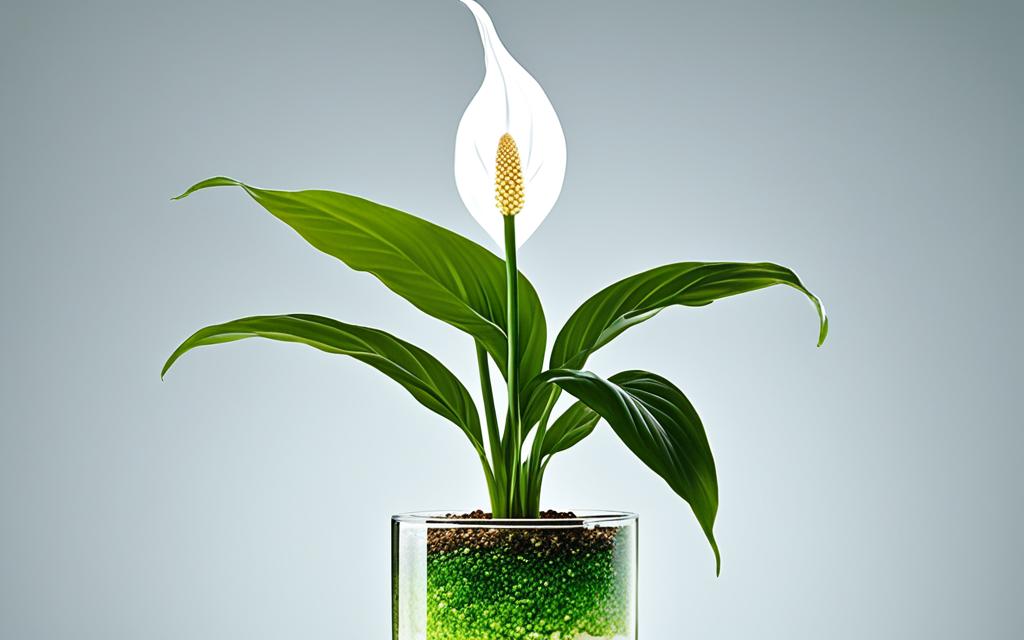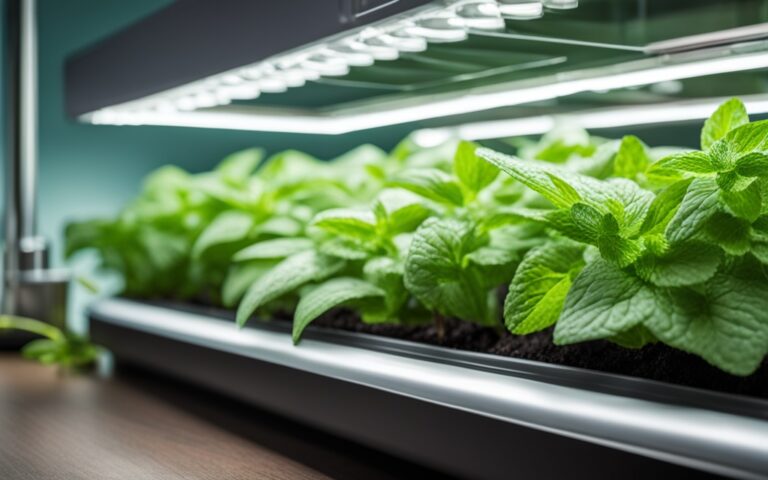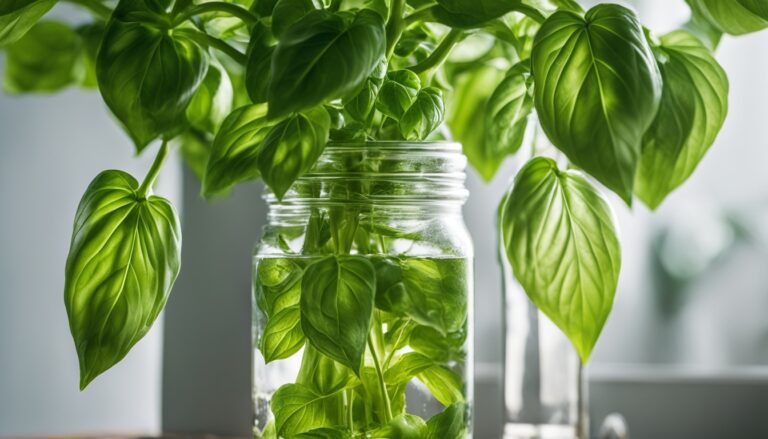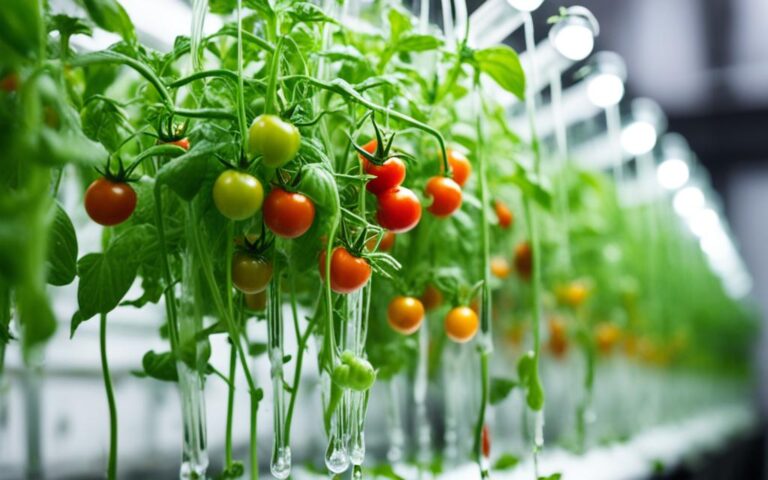Grow a Hydroponic Peace Lily – Simple Guide
Did you know the average American home has over 300 harmful chemicals? The peace lily, grown hydroponically, can clean your air by removing these toxins.
This guide will show you how to grow a healthy hydroponic peace lily. It’s perfect for both new and experienced gardeners. You’ll learn about hydroponic benefits, choosing the right plant, and setting up your system. It also covers managing nutrients, solving common problems, and getting the most blooms for a clean, beautiful space.
Key Takeaways
- Hydroponic peace lilies are great at cleaning indoor air of pollutants.
- They are easy to care for and produce beautiful flowers without soil.
- This guide helps you pick the right plant and maintain a hydroponic system.
- It teaches how to overcome challenges and ensure your plant thrives.
- Switching to hydroponics is easy with the right advice.
Table of Contents
Introduction to Hydroponic Peace Lily Cultivation
Hydroponic gardening is a new way to grow plants without soil. It uses a water solution full of nutrients to feed the plants directly. This method lets people grow many plants, including peace lilies, all year round.
What is Hydroponic Gardening?
Hydroponic gardening means growing plants in water, not soil. Plants get their nutrients from a water solution instead of soil. This way, growers can control the plants’ environment perfectly, helping them grow better.
Benefits of Growing Peace Lilies Hydroponically
- Reduced risk of pests and diseases: Hydroponics keeps pests and diseases away, making plants healthier.
- Improved growth and blooming: Plants get exactly what they need, leading to better growth and more flowers.
- Space-efficient cultivation: Hydroponics fits into small spaces, perfect for those with little room.
- Year-round cultivation: Grow peace lilies anytime, no matter the season or weather outside.
Hydroponic gardening lets peace lily lovers enjoy these plants more. They get to see their plants grow and bloom better, and they can do it all year.
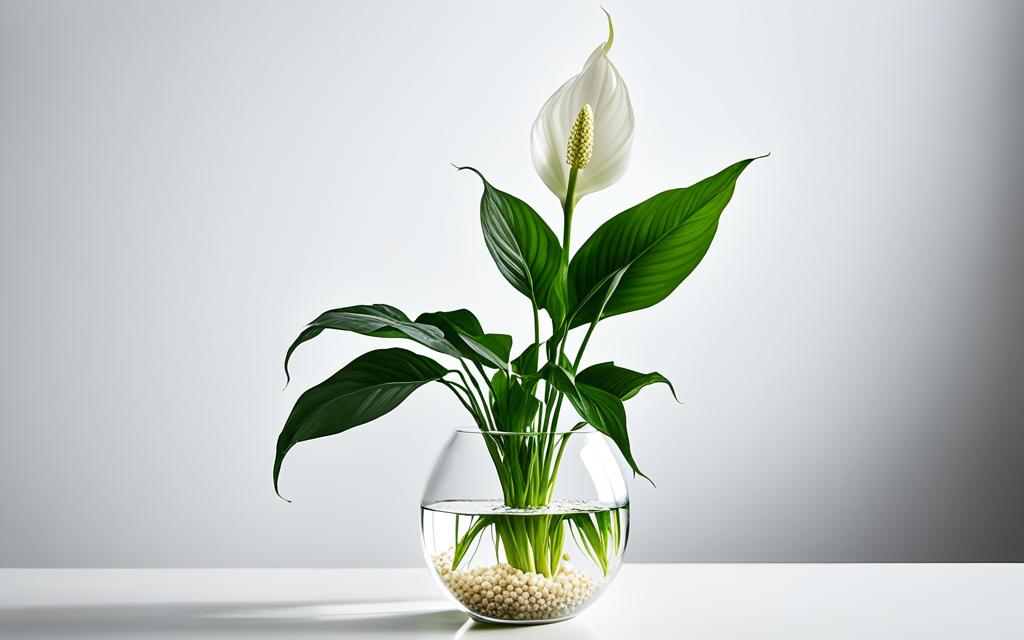
Selecting the Right Peace Lily Plant
When picking a peace lily for your hydroponic garden, choose a healthy, vibrant plant. It should be perfect for indoor growth and hydroponic systems. Look for plants with lush, green leaves and strong roots. Make sure they are free from disease or pests.
Think about getting a compact, dwarf peace lily for your hydroponic setup. These plants do well in small spaces. Stay away from plants that look stressed or have a lot of damage. They might not do well in hydroponics.
Exploring Peace Lily Varieties
The peace lily, known as Spathiphyllum, has many shapes, sizes, and colors. Some top picks for hydroponics are:
- Spathiphyllum ‘Viscount’: A compact, dwarf variety with large, glossy leaves and abundant white flowers.
- Spathiphyllum ‘Domino’: A smaller cultivar with striking, variegated foliage and delicate blooms.
- Spathiphyllum ‘Clevelandii’: A robust, medium-sized peace lily with deep green leaves and long-lasting flowers.
When picking the best peace lily for your hydroponic setup, think about size, foliage, and bloom production. Choose the variety that fits your growing goals and space.
“The key to successful hydroponic peace lily cultivation is to start with a healthy, high-quality plant that is well-suited for the growing conditions you can provide.”
By choosing the right peace lily, you can make your hydroponic garden thrive. Enjoy the benefits of this easy-to-care-for, air-purifying plant for many years.
Setting Up Your Hydroponic System
Switching your peace lily to a hydroponic system is a big step in gardening. First, you need to gather the right materials and pick a hydroponic system that fits your space. Let’s look at what you need for your hydroponic peace lily setup.
Materials Needed
Here are the basic items you’ll need for a hydroponic peace lily system:
- A suitable container or hydroponic system (like a grow tote, net pot, or a dedicated setup)
- A growing medium (if needed), such as perlite, coco coir, or hydroponic substrate
- Hydroponic nutrient solution, made for peace lilies or flowering plants
- A pH meter to check and adjust the solution’s pH
- Any needed accessories, like air pumps, tubing, or grow lights (based on the system)
Choosing the Right Hydroponic System
There are many hydroponic systems for your peace lily. Some easy and popular ones include:
- Deep Water Culture (DWC): This method dips the plant’s roots in a nutrient-rich water solution. It keeps the plant moist and fed.
- Nutrient Film Technique (NFT): Here, a thin nutrient solution flows over the roots. The roots are in a grow tray or channel.
- Kratky Method: The Kratky method is easy and doesn’t need electricity or moving parts. The roots are in a nutrient-rich water reservoir.
Each system has its own setup and care needs. Research to find the best one for your peace lily and space.
Preparing the Peace Lily for Hydroponics
Before moving your peace lily to a hydroponic setup, you need to get it ready. Start by carefully taking the plant out of its soil container. Make sure the roots are clean and healthy for the change.
Removing the Peace Lily from Soil
First, loosen the soil around the peace lily’s roots. Then, slowly work the plant out of its container without harming the roots. Once it’s out, shake off any extra soil from the roots.
Rinsing and Inspecting the Roots
Now, rinse the roots under water. Use your fingers to remove any leftover soil. Check the roots for disease or damage, like discoloration or rot. If you find any, cut off the bad parts with clean scissors or pruners.
Getting your peace lily ready for hydroponics is key to a successful grow.
Planting the Peace Lily in the Hydroponic System
Moving your peace lily from soil to a hydroponic setup is thrilling. It’s a big step in growing this versatile plant. When planting the peace lily in your hydroponic system, focus on details for success.
Begin by carefully taking the peace lily out of its soil container. Make sure to keep as many roots as you can. Then, rinse the roots under cool water to get rid of any soil left.
Check the roots for damage or disease and cut out any unhealthy parts. This keeps your plant healthy from the start.
You might need a growing medium like hydroton (expanded clay pebbles) in your hydroponic system. Put the peace lily into this medium, making sure the crown is above the water. This prevents rot and disease.
If your system lets the roots touch water, place the peace lily’s roots in the nutrient-rich water. Make sure they’re fully covered. Secure the plant if needed to keep it from moving.
The secret to a successful peace lily in hydroponics is handling the roots with care. Also, make sure the plant grows well. With the right setup and attention, your peace lily will do great in its new home.
Lighting Requirements for Hydroponic Peace Lilies
Getting the right lighting is key for hydroponic peace lilies to grow well. They need bright, indirect sunlight, just like their soil-based friends.
Importance of Proper Lighting
Light is vital for photosynthesis, helping peace lilies make their own food. Good lighting also supports strong leaves, roots, and blooms. So, making sure your hydroponic peace lily gets enough light is crucial.
Natural vs. Artificial Lighting Options
- Natural Lighting: Put your hydroponic setup where it gets plenty of filtered sunlight all day. But, don’t put it right under the intense sun to avoid burning the leaves.
- Artificial Lighting: If sunlight isn’t enough, use grow lights. Choose ones that have the right spectrum for growth and flowers. Make sure your plant gets 12-16 hours of light daily and check if it’s getting the right amount.
Knowing what your peace lily needs for light and providing it with the right kind of light will help it thrive in a hydroponic setup.
| Lighting Requirement | Natural Lighting | Artificial Lighting |
|---|---|---|
| Spectrum | Filtered, indirect sunlight | Blue spectrum for vegetative growth, red spectrum for flowering |
| Duration | Bright, indirect light for 12-16 hours per day | Consistent 12-16 hours of illumination per day |
| Positioning | Place hydroponic system in a location with ample, filtered natural light | Use grow lights positioned appropriately to provide even, adequate coverage |
Nutrient Management and Fertilization
When growing peace lilies hydroponically, it’s key to give them a balanced and nutrient-rich solution. These plants can’t get nutrients from soil, so a good hydroponic fertilizer is a must. It should be made for blooming plants.
Essential Nutrients for Peace Lilies
Peace lilies need a diet full of nitrogen, phosphorus, and potassium. These nutrients help with strong leaves, bright flowers, and good health. Make sure your hydroponic fertilizer has the right mix of these, usually around 20-10-20.
Monitoring and Adjusting pH and TDS/EC Levels
Keeping the right pH and TDS/EC levels in the hydroponic solution is also crucial. Peace lilies like a slightly acidic environment, with a pH of 6.0 to 6.5. The TDS/EC should be between 800 and 1200 ppm, as the fertilizer maker suggests.
| Nutrient | Ideal Range for Peace Lilies |
|---|---|
| pH | 6.0 – 6.5 |
| TDS/EC | 800 – 1200 ppm |
Testing and adjusting the pH and TDS/EC levels often helps your peace lily grow well and bloom more.
Water Management and Maintenance
Keeping the water clean and managed right is key for your hydroponic peace lily’s health and growth. Make sure to focus on the water needs and clean your hydroponic setup often.
Water Quality Considerations
For hydroponic peace lilies, clean, high-quality water is a must. Don’t use tap water because it might have chlorine and other bad stuff. Go for distilled, reverse osmosis, or rainwater instead. These are pure and perfect for your peace lily hydroponic water requirements.
Changing Water and Cleaning the System
Always check the water level in your hydroponic setup and add more if it’s low. Make sure the roots are covered but the crown isn’t. To stop algae and other bad stuff from growing, change the water and clean the tank every 1-2 weeks. This hydroponic system maintenance keeps the water perfect for your peace lily.
By managing and maintaining the water well, you’ll give your hydroponic peace lily the best chance to grow and bloom beautifully.
Hydroponic Peace Lily Care and Monitoring
Keeping the right temperature and humidity levels is key for your hydroponic peace lily’s health. With proper grooming and pruning, your peace lily can flourish in the hydroponic system.
Temperature and Humidity Requirements
The best temperature for a hydroponic peace lily is between 18°C and 27°C (64°F to 81°F). This range keeps the plant happy and growing well. Also, keep the humidity level at 40-60% around the plant. This humidity helps keep the leaves moist and supports the plant’s health.
Pruning and Grooming
Regular pruning and grooming of your hydroponic peace lily keeps it healthy and looking good. Check the plant for dead, yellowing, or damaged leaves and cut them off with clean, sharp pruners. This helps the plant focus on growing new, healthy leaves. Also, use a damp cloth to clean the leaves, removing dust and keeping them shiny.
By keeping an eye on your hydroponic peace lily’s temperature, humidity, pruning, and grooming, it will do well in your indoor setup. Providing the best conditions lets you enjoy its beautiful leaves and stunning white flowers for many years.
Common Issues and Troubleshooting
Growing a hydroponic peace lily can be rewarding, but it’s good to know about potential problems. Pests and diseases can harm the plant’s health. Keeping the right balance of nutrients is key for the peace lily to do well.
Identifying and Addressing Common Pests and Diseases
Hydroponic peace lilies face pests like spider mites, fungal issues, and algae. Check the plant and system often to spot problems early. If you see pests or disease, act fast. Isolate the plant and use natural remedies to fix the issue.
Solving Nutrient Deficiencies
It’s vital to keep the right nutrient levels in a hydroponic system for the peace lily. Watch the plant for signs of nutrient lack, like color changes, slow growth, or wilting. Adjust the fertilizer as needed to give the plant the right mix of nutrients.
Regularly check the water’s pH and TDS/EC levels. This ensures they’re perfect for peace lily growth.
By being alert and fixing problems quickly, you can have a healthy hydroponic peace lily. It will make your indoor space look beautiful with its blooms.
| Common Hydroponic Peace Lily Problems | Possible Causes | Solutions |
|---|---|---|
| Spider Mites | Dry air, stress, or poor air circulation | Use insecticidal soap or neem oil, increase humidity |
| Fungal Diseases | Overwatering, poor air flow, or high humidity | Improve air circulation, use fungicide, reduce watering |
| Algae Growth | Excess light, nutrient imbalance, or stagnant water | Reduce light exposure, adjust nutrient levels, clean system |
| Nutrient Deficiencies | Imbalanced nutrient solution, pH issues, or root damage | Test and adjust nutrient levels, maintain proper pH |
Tips for Maximizing Growth and Blooms
To make your hydroponic peace lily grow well, use smart strategies. Make sure it gets enough light, nutrients, and water. Keeping the right temperature and humidity is also important for its health.
Trimming dead or damaged leaves helps the plant focus on growing strong. Adding a special fertilizer can also help it bloom more.
Good air flow around the peace lily is key. It keeps the plant healthy and stops diseases or pests.
| Tip | Description |
|---|---|
| Optimal Lighting | Make sure your peace lily gets enough light, whether from the sun or a lamp, for good growth and blooms. |
| Balanced Nutrition | Give a balanced nutrient mix, adjusting the pH and TDS/EC levels as needed, to fit the peace lily’s needs. |
| Vigilant Water Management | Check and change the water often to keep it clean and working right. |
| Proactive Pruning | Remove dead or damaged leaves to help the plant grow and bloom better. |
| Bloom-Boosting Fertilizer | Think about using a fertilizer made to help peace lilies bloom more. |
| Proper Air Flow | Make sure there’s enough air around the peace lily to keep it healthy and avoid problems. |
Using these tips to maximize peace lily growth hydroponics, increase peace lily blooms hydroponics, and optimize peace lily hydroponic yield will help your plant do its best.
Transitioning from Soil to Hydroponics
If you’re moving your peace lily from soil to hydroponics, do it step by step. This careful process helps prevent shock and makes the move easier for your plant.
Gradual Acclimation Process
Start by putting the peace lily in a container with water and a bit of its old soil. Slowly add more water and less soil over a week or two. This way, the plant gets used to the hydroponic solution.
This slow change helps the plant adjust to new conditions. It gets used to different nutrients, water, and oxygen levels. By going slow, your peace lily will do well in its new hydroponic setup.
- Start with a mix of water and a small amount of the original soil.
- Gradually decrease the soil content over the course of 1-2 weeks.
- Increase the water proportion until the peace lily is growing solely in the hydroponic solution.
Remember, making the peace lily adjust to hydroponics is key for its success. By taking it slow, you help your plant flourish in its new home.
“The key to successfully transitioning a peace lily from soil to hydroponics is patience and a gradual approach. Take it step-by-step, and your plant will thank you.”
Creative Display Ideas for Hydroponic Peace Lilies
Displaying your hydroponic peace lily can be a visually captivating experience. Consider putting the plant in a transparent vase or container. This lets you see the roots and water, adding a modern, minimalist look to your space.
For a decorative touch, put the plant in a tabletop or wall-mounted hydroponic system. These systems make the peace lily part of your home decor. Add decorative stones, marbles, or natural elements to make your display look better and highlight the plant’s beauty.
If you want a hydroponic peace lily decor that really pops, hang the plant from the ceiling or mount it on a wall. This way, you show off the plant’s elegance and save space in your home.
“The beauty of a hydroponic peace lily lies in its ability to thrive while showcasing its intricate roots and lush foliage. By getting creative with its display, you can transform your living space into a botanical oasis.”
Whether you like a simple, modern look or something more elaborate, hydroponic peace lilies can fit your style. Try different materials, places, and lighting to find the best way to show off your decorative hydroponic peace lily. This will add natural beauty to your home.
Conclusion
Growing a hydroponic peace lily is rewarding and easy. This guide shows you how to move your peace lily from soil to water. You’ll see better growth, fewer pests, and easy control over the plant’s care.
It doesn’t matter if you’re new to indoor gardening or have been doing it for years. Hydroponic peace lily cultivation is a great way to beautify your space and clean the air. These plants are great for indoor gardens because they grow well in controlled conditions and clean the air we breathe.
Knowing the benefits of growing hydroponic peace lilies helps you decide to switch to a hydroponic system. This guide has given you the knowledge to start this journey. Now, you can create a beautiful and healthy indoor garden with your peace lilies.
